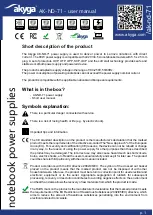
18
MILL
10. Recheck perpendicularity using the dial indicator.
Repeat the procedure above until the dial indicator
reads zero in both positions.
11. Tighten the four hex nuts. Tighten in two steps using
a calibrated torque wrench. Use a crossing pattern
to tighten the nuts. Tighten initially to 25 foot-pounds,
then tighten to a final torque of 50 foot-pounds.
10.2 MILL HEAD – FORE/AFT ADJUSTMENT
1. Setting the angle:
a. Loosen the three ram adapter clamp bolts on the
ram (A, Figure 19). There is no need to loosen the
bolts more than 1/2 turn to allow tilting.
b. Support the mill head with your free hand. Press
upward on the spindle when changing the angle.
c. Turn the ram adapter worm nut (B, Figure 19) to tilt
the head forward and backward. Use the scale on the
ram adapter to locate the desired angle.
2. Returning to upright position:
a. When returning the mill head to its full upright posi
tion, be sure to support the head by upward pressure
on the spindle as you turn the worm nut.
b. Check to make sure the mill head is perpendicular
to the worktable.
2. Turn the worm nut (B, Figure 18) to tilt the head left or
right as required. Use the scale on the ram adapter to
set the desired angle.
Note: The scales on the ram adapter and for head rota-
tion are guides only. Close tolerance work will require
the use of a dial indicator to make sure the head is 90°
to the table in the X and Y axis. Please note the table
is fitted to be slightly higher in front, usually about
0.0005”.
3. Tighten the four hex nuts. Tighten in two steps using
a calibrated torque wrench. Use a crossing pattern to
tighten the nuts. Tighten initially to 25 foot-pounds.
4. Before applying final torque, check to make sure the
mill head is perpendicular to the worktable.
5. Set up a dial indicator in a collet and secure using the
draw bar (refer to Figure 20).
6. Put the spindle drive in neutral.
7. Set the dial indicator plunger on the worktable. Zero
the
indicator.
8. Rotate the spindle 180 degrees (when rotating, raise
the dial indicator plunger by hand to prevent it from
dropping into the table T-slots).
9. Read the dial indicator. The indicator should read
zero. If not, loosen the four hex nuts and reposition the
mill head.
!
Be sure to apply torque in two steps using a cross-
ing pattern. Failure to do so could distort the face
of the ram adapter.
Be sure to apply torque in two steps using a cross-
ing pattern. Failure to do so could distort the face
of the ram adapter.
!
Fig. 18
B
A
A
Fig. 19
B
A
Summary of Contents for ETM-949
Page 9: ...9 ETM 949 ETM 949EVS Fig 2 ETM 949 DIMENSIONS ...
Page 12: ...12 MILL Fig 5 Fig 4 Motor Switch ...
Page 25: ...25 ETM 949 ETM 949EVS TABLE ASSEMBLY ETM 949 ETM 949EVS ...
Page 48: ...48 MILL 14 0 WIRING DIAGRAM ETM 949 ...
Page 49: ...49 ETM 949 ETM 949EVS WIRING DIAGRAM ETM 949EVS E type inverter ...
Page 50: ...50 MILL WIRING DIAGRAM ETM 949EVS B type inverter ...
Page 51: ...51 ETM 949 ETM 949EVS NOTES ...
Page 52: ...52 MILL NOTES ...
















































